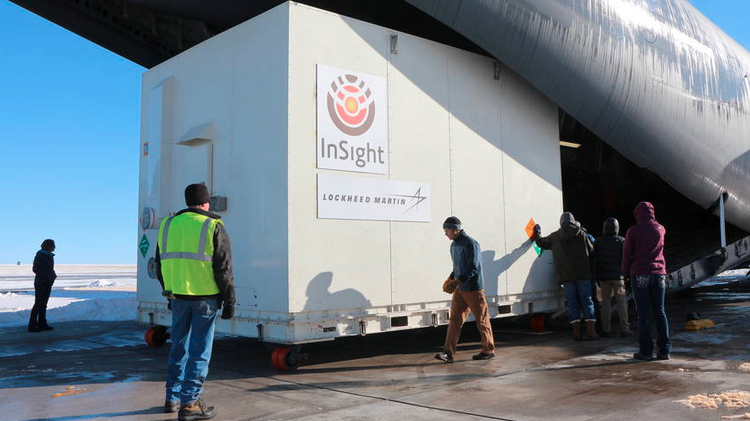NASA’s next space probe headed to Mars — a lander built in Jefferson County and launched on a Colorado rocket — may soon start its journey Saturday after two years of waiting.
The Mars InSight lander, built by Lockheed Martin Space, is scheduled to lift off before dawn.
NASA originally scheduled the $828.8 million mission to blast off two-and-a-half years ago. A problem with a seismic instrument, built by France’s Centre National d’Études Spatiales (CNES), prompted NASA to postpone launching InSight until the next time Mars’s orbit aligned with earth’s for an optimal flight.
The planets come into that alignment this week, making 4:05 a.m. Saturday the start of the first two-hour window that will work for liftoff.
“We’ve never really had a situation like this,” said Stu Spath, director of deep space programs for Lockheed Space and who oversaw the InSight project. “It’s good to get on top of the rocket, and everything is looking good.”
The InSight spacecraft and launch teams are ready. However, Air Force forecasts show an 80 percent chance of coastal fog heavy enough to scrub the pre-dawn launch due to poor visibility. If fog forces more waiting, there are other launch times that will work to launch InSight prior to June 6.
The Mars InSight lander, formally called the Interior Exploration using Seismic Investigations Geodesy and Heat Transport, is designed to land and then drill nearly 16 feet beneath the Martian surface and monitor the subsurface temperature. Other instruments will take surface seismic readings.
The mission is expected to yield new information about the red planet’s interior — such as the composition of its core — and its geological processes.
Lockheed Martin Space led construction on the multi-national mission. The company, which has been a key player on seven previous NASA Mars missions, won the $425 million contract to build InSight in 2012.
The probe is 8.5 feet in diameter and weighs about 400 pounds. With its heat shield and entry vehicle enveloping it, the overall Insight payload resembles the size of a very small car.
InSight will blast off atop an Atlas V rocket built by Centennial-based United Launch Alliance, which has launched all NASA planetary probes since 2006.
Around 11 a.m. Nov. 26, if all goes according to plan, InSight will descend through Mars’ atmosphere at nearly 12,000 miles per hour.
A heat shield will ward off most of the friction and slow InSight, inside its protective aeroshell, enough for parachutes to deploy and slow the craft further.
Close to Mars’s surface, the parachutes release InSight and thrusters fire to provide it a gentle five-mile-per-hour landing in the planet’s western Elysium Planitia region.
“It’s a nail-biting seven minutes,” Spath said of InSight’s descent and landing. But it’s very similar to the landing of NASA’s Phoenix lander mission to Mars in 2008, which the company oversaw. “It’ll be a nervous time, but we’ve gone through it previously and we’re confident we can do it again.”
U.S. and European space agencies built the scientific instruments that Lockheed Martin Space integrated into the InSight lander.
In a 2015 file photo, NASA’s Mars-bound InSight spacecraft is loaded into a C-17 cargo aircraft at Buckley Air Force Base that was bound for Vandenberg Air Force Base, California. The spacecraft, built by Lockheed Martin Space Systems, was scheduled for launch that year but was… more
Since the last time it was shipped to California for its late 2015 launch, French engineers and NASA’s Jet Propulsion Laboratory redesigned a problematic vacuum seal on the lander’s key seismic instrument. The delay and repair added $153.8 million to the original cost of the mission, according to NASA.
InSight’s replacement seismic instrument was installed, integrated and tested extensively at Lockheed’s campus in Colorado before sending the lander back to California in February.
A team of 25 Lockheed Martin Space employees have been with the lander there for three months, and another 25 traveled there this week for InSight’s launch.
Getting the spacecraft on its way to Mars will be a big deal for the company.
About 150 people worked on the probe at the height of assembly activity, and well over 1,000 employees there will have a hand in the mission over the six years it has been in development, Spath said.
InSight will be the first interplanetary probe to take off from Vandenberg Air Force Base. All others have launched from NASA’s Kennedy Space Center in Cape Canaveral, Florida.
The preparation for this week’s launch date has been different from two years ago, Spath said.
In 2016, Lockheed Martin Space teams weren’t familiar with the West Coast launch site. And then there was the problem instrument and the possibility of integrating the new one at the launch site to keep InSight on schedule.
“We knew things were coming in late, and things were pretty frantic closing in on the 2016 launch,” Spath recalled. “This go-around, it’s been much more tempered.”
Once InSight leaves earth, a team from Lockheed’s Waterton campus will monitor and spacecraft from Colorado and make any adjustments needed for its flight.
The same crew will oversee InSight’s flight down through the Martian atmosphere and its time on Mars soil, too. It’s a “cradle-to-grave” job to make sure InSight is operating healthily, Spath said. That’s designed to be 728 earth days on the red planet, but will continue until NASA decides InSight’s job is done.
It will be the seventh space probe managed from the company’s spacecraft operation’s center.



